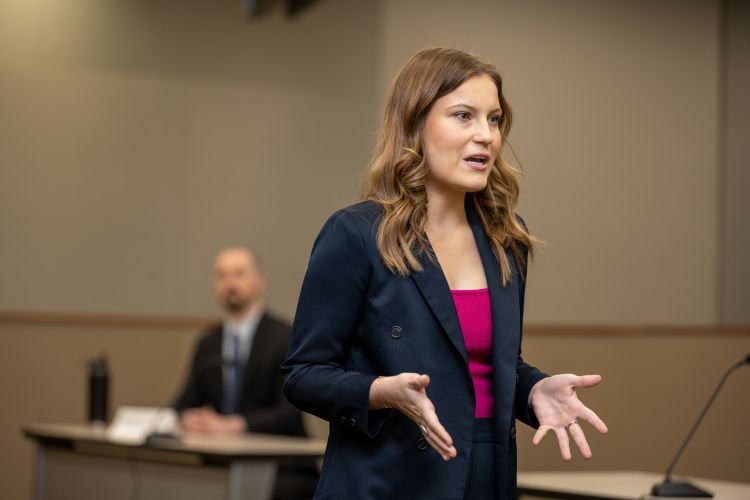From Concept to Courtroom: Steps to Create Effective and Persuading Trial Presentations
From Concept to Courtroom: Steps to Create Effective and Persuading Trial Presentations
Blog Article
Just How to Develop Involving Test Discussions That Win Over Juries and Judges
Crafting engaging trial discussions that astound juries and judges is a nuanced art that requires a calculated approach. By employing cutting-edge aesthetic tools, including interactive aspects, and devoting time to strenuous method and rehearsal, lawful experts can considerably boost the effect of their courtroom discussions.
Understanding Your Target Market
To efficiently involve your audience throughout trial presentations, it is crucial to comprehend their preferences, assumptions, and degree of expertise in the topic. By tailoring your discussion to meet the certain needs of the target market, you can enhance their understanding and retention of the details provided.
Begin by looking into the demographics of the audience, such as age, education and learning level, and profession. This details can help you assess their familiarity with legal treatments and adjust your presentation design accordingly. For instance, a court may need less complex language and even more visual aids contrasted to a group of legal specialists.
Furthermore, think about the emotional and psychological aspects of your audience. Are they understanding towards specific debates or more inclined in the direction of facts and evidence? Recognizing these subtleties can help you frame your presentation in such a way that reverberates with the target market on a deeper level.
Storytelling Methods
Comprehending your target market's choices and assumptions can dramatically affect the performance of your test presentations, especially when carrying out narration methods to mesmerize and convince. Narration is an effective tool that can assist attorneys link with discretionary on a more emotional level, making complex legal arguments extra remarkable and relatable.

Integrating brilliant details, personal anecdotes, and ornate gadgets can additionally enhance the storytelling experience, maintaining the target market engaged and spent in the outcome of the instance. By crafting an influential story that resonates with the worths and emotions of the jury and courts, attorneys can boost the opportunities of winning their debates and accomplishing beneficial verdicts.
Aesthetic Presentation Devices
Using aesthetic presentation devices can considerably enhance the influence and efficiency of trial discussions by offering an aesthetically appealing way to share complex details to juries and courts. Visual help such as charts, animations, representations, and graphs can assist streamline elaborate information, making them much more accessible and easy to understand to the audience. By integrating aesthetic elements into test discussions, lawyers can develop a compelling story that reverberates with jurors and leaves a long lasting impact.

Integrating Interactive Components
Including interactive elements into test discussions can enhance audience engagement and understanding, cultivating a more interactive and immersive court room experience. By incorporating elements such as interactive timelines, 3D animations, clickable exhibitions, and online fact repairs, attorneys can astound courts and jurors, making intricate information much more accessible and memorable.
Interactive timelines allow for a dynamic my website display screen of chronological occasions, helping the target market comprehend the series of vital occurrences in a case. 3D animations can bring crime scenes or accident reconstructions to life, providing an in-depth graph that assists in clarifying intricate information. Clickable displays make it possible for customers to connect with proof, papers, or pictures, permitting a hands-on exploration of vital info.
Furthermore, virtual reality repairs can move the target market into the heart of the action, providing an more information engaging viewpoint that standard presentations may do not have. These interactive aspects not only involve the audiences however also encourage them to check my blog proactively join the test process, resulting in a more impactful and persuasive court discussion.
Practice and Rehearsal
To effectively utilize the possibility of interactive aspects in trial discussions, thorough technique and wedding rehearsal are important to ensure smooth combination and delivery in the court room setting. Practice and practice session assistance trial speakers become knowledgeable about the material, timing, and flow of their discussions, enabling them to with confidence browse through various elements such as video clips, animations, or interactive graphics. By rehearsing their delivery, speakers can refine their talking skills, body language, and overall discussion style to improve persuasion and reliability before the jury and court.
During practice, presenters can recognize any type of technological problems that might occur with interactive components, guaranteeing that whatever runs efficiently during the real test. Additionally, practicing before a mock target market or colleagues can offer beneficial responses on the efficiency of the interactive parts and the overall discussion. This responses allows presenters to make essential adjustments and enhancements prior to stepping right into the court, inevitably increasing the effect and success of their test discussions.
Conclusion
In final thought, developing interesting trial presentations that astound courts and courts calls for a deep understanding of the audience, effective storytelling methods, aesthetic devices, interactive components, and comprehensive technique (Trial Presentations). By executing these methods, lawyers can effectively convey their arguments and evidence in a compelling way that resonates with the decision-makers in the court
Using aesthetic presentation tools can substantially boost the influence and effectiveness of test discussions by providing a visually interesting way to convey complex information to judges and courts. By including aesthetic aspects into trial discussions, legal representatives can develop an engaging narrative that resonates with jurors and leaves a long lasting impression.
One popular aesthetic discussion device is the use of multimedia presentations, which allow for the integration of videos, pictures, and audio recordings to supplement spoken disagreements. Trial Presentations.To successfully take advantage of the potential of interactive elements in test presentations, extensive practice and rehearsal are crucial to make certain smooth integration and delivery in the court room setting. Practice and practice session assistance trial speakers come to be acquainted with the content, timing, and circulation of their presentations, permitting them to with confidence navigate via different components such as video clips, animations, or interactive graphics
Report this page